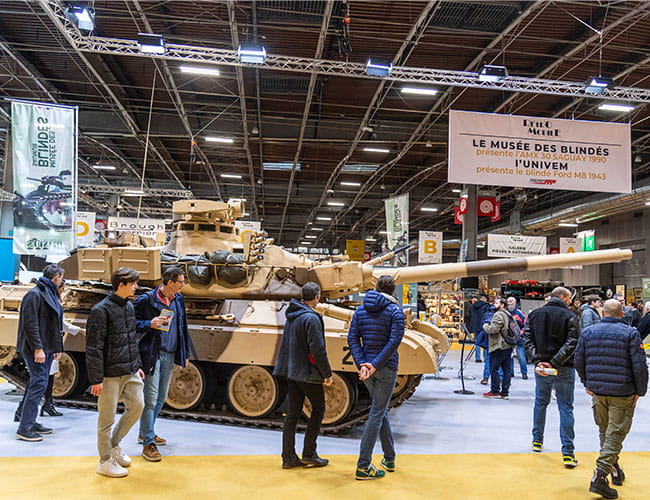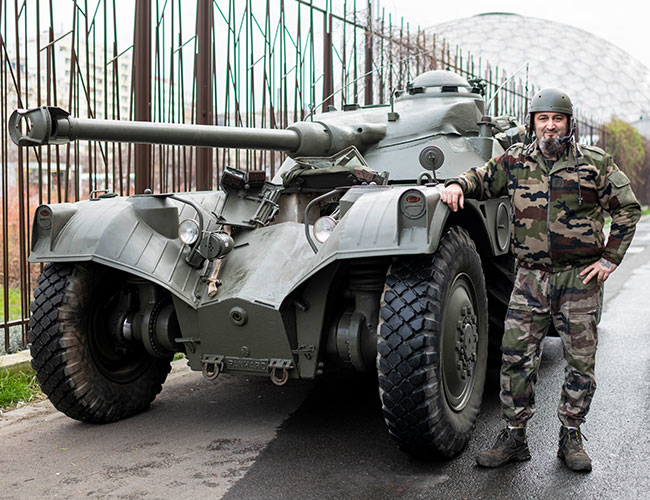The AMX 30 TANK and the PANHARD EBR
The AMX 30 TANK
For the 47th edition of the Rétromobile show, the Musée des Blindés de Saumur presents an emblematic tank of the French military industry, the AMX 30. Built in the Ateliers de construction d'Issy-les-Moulineaux, it was put into service in 1957 and served the colours of France for 50 years. For its time it was a modern armoured vehicle, its silhouette was very low and thanks to its powerful Hispano Suiza 12-cylinder flat engine, the AMX 30 was very manoeuvrable and could quickly reach 65 km/h.
Thanks to its one-piece moulded turret and its perfectly waterproof hull, the AMX 30 could operate in a contaminated atmosphere and cross rivers 4 m deep.
Over 3 m wide with its 75 mm thick armour, the AMX 30 remains imposing to this day.
The AMX 30 presented at the show is one of the latest modernised versions specially equipped for desert regions. It took part in Operation Daguet in the Gulf War conflict in southern Iraq from 1990 to 1991.
Technical sheet of the AMX30 :
- Service: 1957 to 2011
- Production: 3,571 units
- Length: 6.60 m Width: 3.10 m
- Weight according to the version: from 36 to 40 tons
- Totally sealed body: river bottom passage, nuclear, biological and chemical protection.
- Armament : one 105 mm gun 47 shells - one 7,62 mm machine gun 2000 cartridges - one 20 mm machine gun 480 shells
- Engine: Hispano Suiza poly-fuel 720 hp - 12 flat cylinders turbo - 28.700 cm3
- Consumption: 190 litres per 100 km
- Speed: 65 kph

Dynamic presentation of EBR PANHARD TANKof the Musée des Blindés
This year, the team of the Musée des Blindés de Saumur will present a Panhard Armoured Reconnaissance Engine in dynamic demonstration. This tank adopts revolutionary technical solutions. The prototype was built in 1939. Equipped with 8 wheels, 4 of which are entirely metallic and can be lifted to facilitate road travel. The German invasion of 1940 stopped the development of this tank. In 1948 the principles of the wheeled tank were taken up again and Panhard produced the first EBR in 1952. This armoured vehicle has the advantages of a contemporary armoured vehicle. Very low silhouette, 8 driving wheels, 4 of which can be lifted on the road, the 4 wheels equipped with puncture-proof tyres are steered. The hull is symmetrical, the front and the rear are identical and each one is equipped with a cockpit and a reverser of controls which makes it possible not to turn over. The engine is a jewel of goldsmithery, 12 flat cylinders with air cooling, light alloy engine block, crankshaft and connecting rods mounted on bearings. The 200 hp propelled the EBR to over 100 kph.
At the time, the Willys Jeeps of the French army that accompanied the EBR on open roads had a hard time keeping up with the convoy. The EBR is a brilliant example of Panhard's technical creativity.
Technical sheet of the EBR PANHARD :
- Commissioned: 1952
- Length: 2.40 m
- Width: 2.30 m
- Weight: 13 tons
- Crew: 4 men
- Production: 1200 units
- Symmetrical body, a cockpit at each end.
- Armament: one 75 mm gun -3 7.5 mm machine guns
- Engine: 12 air-cooled flat cylinders of 200 hp
- Displacement: 6 litres
- Propulsion: 8 driving wheels, 4 of which can be lifted.
- Fuel tank: 380 litres
- Range: 700 km
- Consumption : 54 litres per 100 km
- Speed : 115 kph


